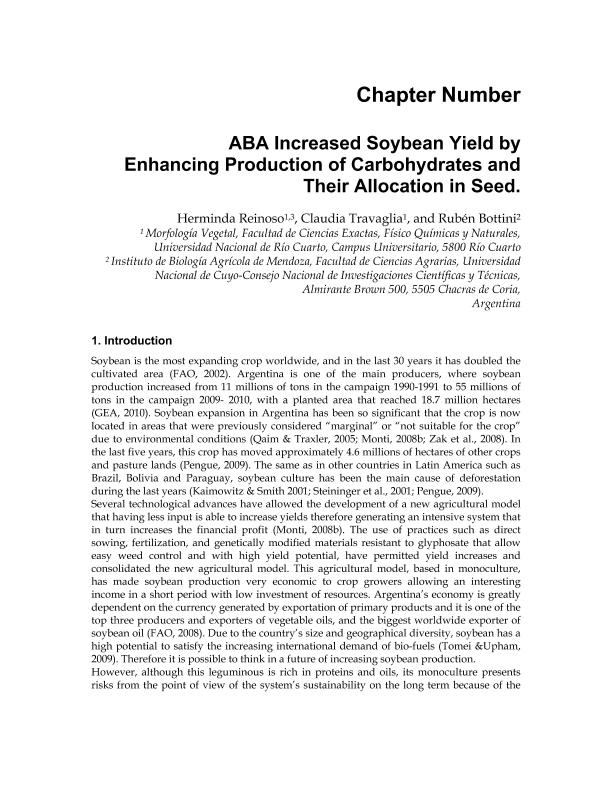Capítulo de Libro
ABA increased soybean yield by enhancing production of carbohydrates and their allocation in seed
Título del libro: Soybean - Biochemistry, Chemistry and Physiology
Reinoso, Herminda Elmira; Travaglia, Claudia Noemi ; Bottini, Ambrosio Rubén
; Bottini, Ambrosio Rubén
 ; Bottini, Ambrosio Rubén
; Bottini, Ambrosio Rubén
Otros responsables:
Ng, Tzi-Bun
Fecha de publicación:
2011
Editorial:
Intech Open Access Publisher
ISBN:
978-953-307-219-7
Idioma:
Inglés
Clasificación temática:
Resumen
Soybean is the most expanding crop worldwide, and in the last 30 years it has doubled the cultivated area (FAO, 2002). Argentina is one of the main producers, where soybean production increased from 11 millions of tons in the campaign 1990-1991 to 55 millions of tons in the campaign 2009- 2010, with a planted area that reached 18.7 million hectares (GEA, 2010). Soybean expansion in Argentina has been so significant that the crop is now located in areas that were previously considered “marginal” or “not suitable for the crop” due to environmental conditions (Qaim & Traxler, 2005; Monti, 2008; Zak et al., 2008). In the last five years, this crop has moved approximately 4.6 millions of hectares of other crops and pasture lands (Pengue, 2009). The same as in other countries in Latin America such as Brazil, Bolivia and Paraguay, soybean culture has been the main cause of deforestation during the last years (Kaimowitz & Smith 2001; Steininger et al., 2001; Pengue, 2009). Several technological advances have allowed the development of a new agricultural model that having less input is able to increase yields therefore generating an intensive system that in turn increases the financial profit (Monti, 2008). The use of practices such as direct sowing, fertilization, and genetically modified materials resistant to glyphosate that allow easy weed control and with high yield potential, have permitted yield increases and consolidated the new agricultural model. This agricultural model, based in monoculture, has made soybean production very economic to crop growers allowing an interesting income in a short period with low investment of resources. Argentina’s economy is greatly dependent on the currency generated by exportation of primary products and it is one of the top three producers and exporters of vegetable oils, and the biggest worldwide exporter of soybean oil (FAO, 2008). Due to the country’s size and geographical diversity, soybean has a high potential to satisfy the increasing international demand of bio-fuels (Tomei & Upham, 2009). Therefore it is possible to think in a future of increasing soybean production.
Palabras clave:
Soybean
,
ABA
,
carbohydrates
Archivos asociados
Licencia
Identificadores
Colecciones
Capítulos de libros(IBAM)
Capítulos de libros de INST.DE BIOLOGIA AGRICOLA DE MENDOZA
Capítulos de libros de INST.DE BIOLOGIA AGRICOLA DE MENDOZA
Citación
Reinoso, Herminda Elmira; Travaglia, Claudia Noemi; Bottini, Ambrosio Rubén; ABA increased soybean yield by enhancing production of carbohydrates and their allocation in seed; Intech Open Access Publisher; 2011; 23-33
Compartir
Altmétricas



